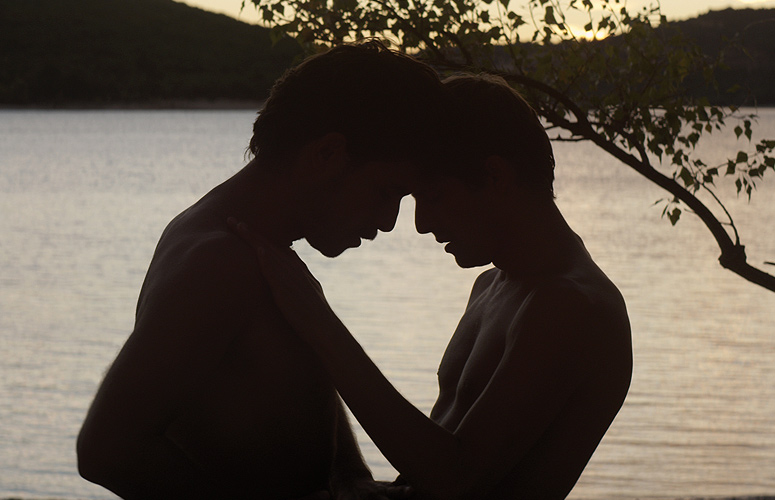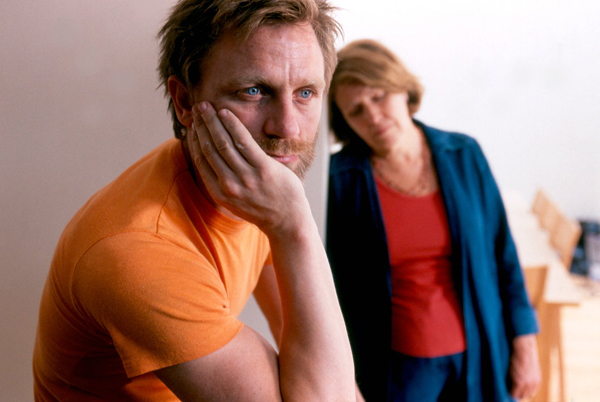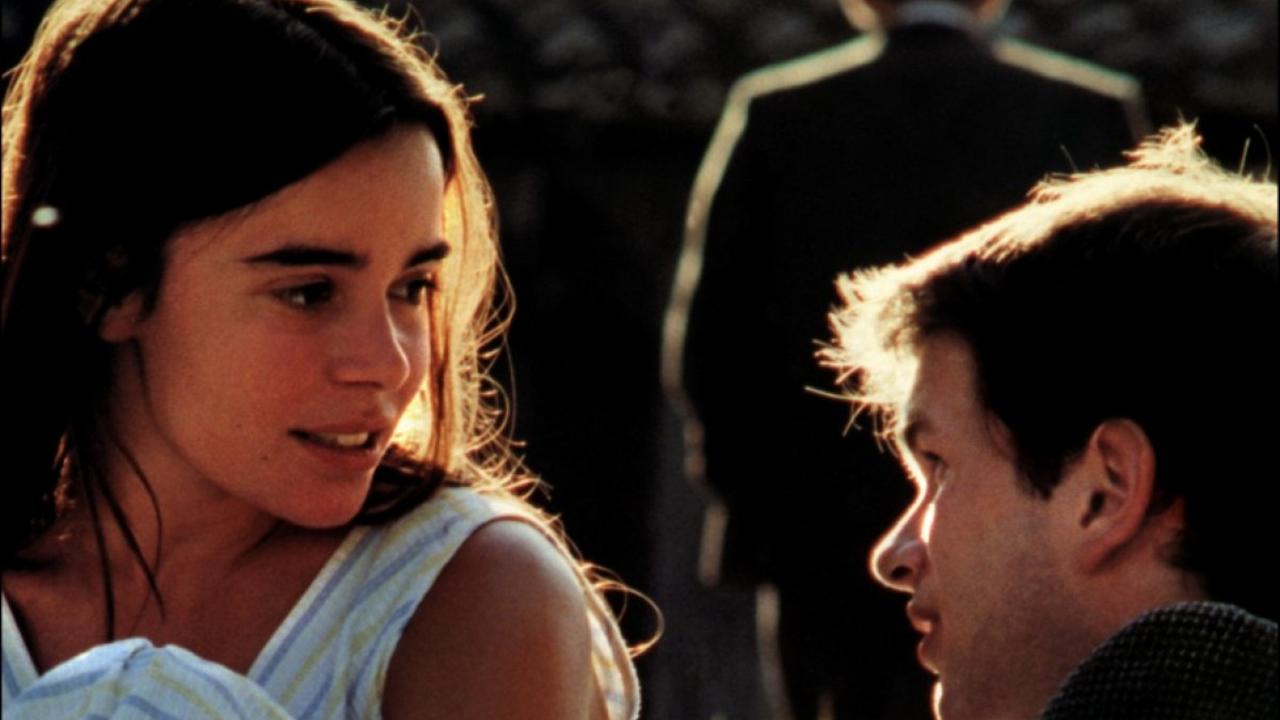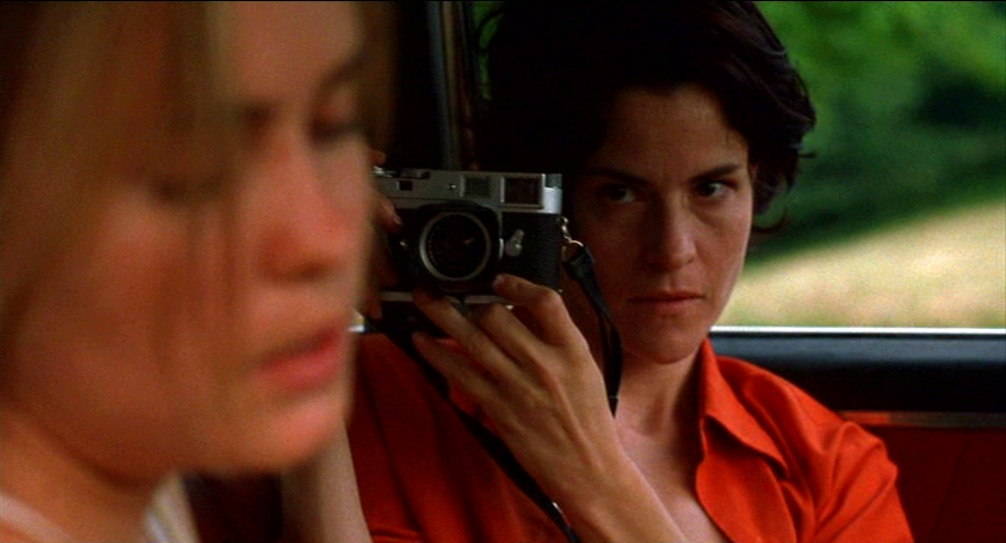5. Stranger by the Lake (2013)

Fear, curiosity, fascination, and intoxication. These are the feelings you can’t avoid, if you completely immerse into the blurry waters of the symbolic abyss that emerges in Alain Guiraudie’s “Stranger by the Lake.” One could walk upon the film’s surface and perceive it as a realistically portrayed story. However, in order to dive into its content and grasp its deeply hidden core, one should perceive this piece as its protagonist’s surreal portrait.
A lake, a beach, and naked men comprise the picture’s fundamental elements. This is our hero’s nature. Franck is found in this remote simplistic natural setting, as if ready to explore it, decompose it, and finally conquer it. One day, his attention is taken by a physically flawless and distant man, for whom he’s received cautionary information. Ignoring, or more aptly, integrating this warning, Franck gives up to a thrilling sexual relationship with Michael.
The film’s catholic landscape describes Franck’s psychological profile, as it resurfaces from his sexuality’s bedrock. He seeks indulgence and psychosomatic communication, aiming to a sentimental bond that can’t find a solid grip. But his daring and thirsty nature can’t resist to a carnal perfection that deserves utilization, and Franck willingly sinks in the thick black waters of an unknown and dangerous pleasure.
4. The Mother (2003)

There’s something very comforting in the British film “The Mother” by Roger Michell: You don’t have to understand why its characters need and pursue various circumstances, as you can’t do so in real life. What Michell and writer Hanif Kureishi want us to do is to accept. Apart from this soft earthly ingredient, the rest of the film’s foundation describes what we could easily call an “unsolved every-day drama.”
May is a middle-aged, recently widowed woman that lives in British countryside. She’s decided to move in London, since she can’t stand the idea of a lonesome provincial life. Her relationship with her two children seems to be typical and spiritless, and so seems her new life for a while. Until, May discovers her daughter’s illegal affair. Her first hearty reaction is to approach Paula’s lover and develop a sexual relationship with him, on a first level, and a strong sentimental bond on a second, higher level.
Throughout this course, one wonders about the inquisitive decisions and involvements of the characters. Of course, the answers aren’t easy to be found and explained in simple psychological term. Their nature is based on a complex backdrop, as are their possessors.
Instead of indicating motives and targets, the creators unfold their realistically miserable and multidimensional figures, as they appear on the shadows of their hurt ego and as they use their eroticism to heal their wounds and discover the lost pieces of a life.
3. Eden and After (1970)

Alain Robbe-Grillet’s most acknowledged work is his script for the debated and highly divisive “Last Year at Marienbad.” In the same fashion, his directing attempts maintain a delirious sentimentalism and a haywire kinesiology of script, context, imagery, and setting.
His 1970 “Eden and After” is a tangled, artfully conjured roll of ideas, emotions and perceptions. Using a chromatic synthesis that reminds of Jean-Luc Godard colored films and incorporating a mood that emerges in Dario Argento’s works, this piece is a terrifying riddle.
Displaying a minimum role for the context’s exposition, the plot involves a group of university students reenacting crime scenes in the “Eden” café. Their juvenile games land on reality when an unknown older man appears and changes the setting. In an unstructured flow, the film evolves into a sometimes dream-like and sometimes nightmarish chase of truths, external and internal discoveries. Violette, the most curious of the students, is found in the epicenter of this surreal labyrinth.
Exposed on an absolutely stunning canvas of colors and shapes, and reflected on a deforming mirror of deeply hidden genuine instincts, the film’s quintessence is difficult to be touched. As if waking in its maze with the eyes tied, one can sense the protagonist’s terrors, conquers and development, until her final destination which is set on a field of cognitive, emotional and sexual self-awareness. Whether or not you comprehend “Eden and After,” you can’t ignore that every frame of its visual synthesis comprises a piece of art.
2. The Wild Reeds (1994)

An absolutely personal work, André Téchiné’s 1994 “The Wild Reeds” reformulates the recollections of his adolescence in Southwest France during the 1960s. The story describes a setting stigmatized by sociopolitical instability that influenced the textures of the social fabric, as well as the inner personal functions of its vulnerable members. Respectful of the past and sincere with the present, this film talks about the people who lived under the shadow of the Algerian war.
Francois is at the peak of his adolescence, confused about his sexuality and lacking experience. His best friend is a girl called Maite, but it seems that their relationship doesn’t hide any erotic undertones, as it usually happens.
Eventually, Francois becomes fond of Serge, a male friend with whom he has a premature intercourse. But the things don’t evolve as Francois would desire. When he’s completely convinced about his homosexual nature, he struggles to find the proper way to express and channelize toward the right direction his real self.
The film opens with a wedding scene. This wedding is an escape exit for the groom, who would otherwise be obliged to participate in the war. Of course, this coercive decision doesn’t lead him to purification. Although it seems that this opening scene takes place in order to describe the story’s social background, it’s quite symbolic for the heroes’ portraits.
Essentially, the film suggests that escaping from a prison doesn’t necessarily lead to a granted freedom. In life, sometimes after one prison there’s another one built by circumstances, by society, or even by you.
1. High Art (1998)

Mundanely charming, meticulous to the detail, and defined by a flowing sensual beauty, “High Art” by Lisa Cholodenko is one of the best films ever made about the sexual attraction and romance between women. It all begins when Syd, a successful and settled 24-year-old woman, knocks the door of a neighbor so as to complain about something. Then, as it happens in reality, life assumes the mantle of the game and the players can’t do nothing but participate.
Syd works in an esteemed magazine company and lives with her longtime boyfriend. Along these lines, her daily routine is easy and steady, freed by substantial problems. But is this what she really needs? Visiting the apartment of a new neighbor, she meets Lucy, a formerly famous photographer, currently in her early forties and retired. The two women progressively meet and develop a bidirectional interest, which is on a first level based on their relevant professional activity.
Yet, nothing can prevent the underlying eroticism that follows the interaction of the two women. Lucy is a drug-addict. She’s retired, even though she seems to despise her indolence. On Syd’s face Lucy recognizes an active, non-addicted aspect of herself. Syd, on the other hand, can’t help falling in love with the mysterious and concerned mind of this woman.
There’s sensuality, romance, and competition in this relationship. Cholodenko built her characters and their romance by using real material of very solid quality. This is the reason behind this picture’s irresistible allure.